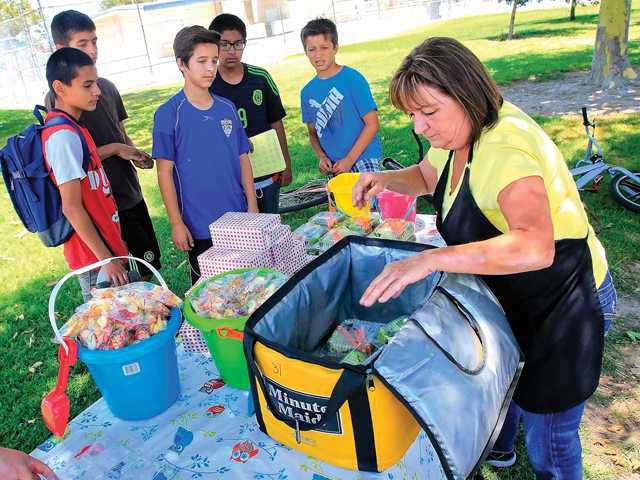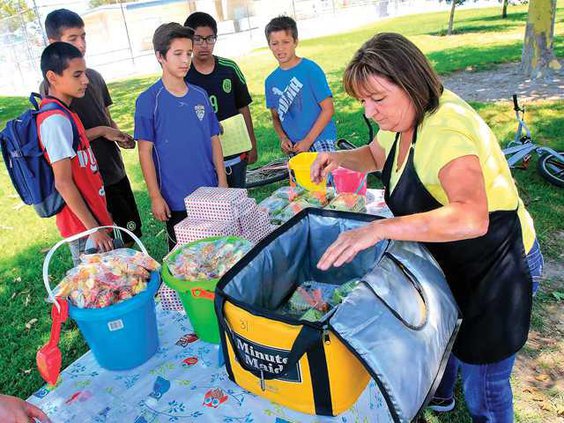By DENNIS WYATT
The Bulletin
Patti Page and her staff don’t teach students.
But studies — as well as testimonials from Manteca Unified teachers — indicate the work they do is vital to helping kids learn.
Page serves as director of the Manteca Unified Nutritional Education. When school starts next week they expect to serve 16,000 lunches each day. Most of the students, though, won’t pay for lunch. That’s because 62 percent of the district’s 23,500 students in Manteca, Lathrop, Weston Ranch and French Camp are eligible for free or reduced meals through the National School Lunch and Breakfast program.
Elementary lunch for students is $2 while high school lunch is $2.25.
The free and reduced lunch program uses a sliding scale to determine eligibility. For example, a household with four in it making $31,525 a year qualifies for free student meals. A family of four with an annual household income between $31,526 and $44,863 is eligible for reduced meals. A single parent with a child that makes less than $20,709 qualifies for free meals while those making between $20,710 and $29,471 qualify for reduced meals.
But because of how well the food service is operated — it covers all of its costs without being subsidized by the general fund — the district is able to drop the 25 cent charge the federal government usually requires for those that qualify for reduced meals and not free meals.
Page noted students who have good nutritional meals and aren’t hungry are better behaved, have better attention, and retain more of what they learn. Retention of learning is one of the driving forces behind the federal effort to make sure kids have at least one nutritional meal Monday through Friday during the summer.
Breakfast served
daily in classrooms
The free meal program during the school year also enhances the learning environment for all students regardless of income.
As for the breakfast program, the district has gotten positive input back from paying parents who struggle to feed their children in the morning.
“Often times both parents are out the door and commuting to the Bay Area leaving an older sibling in charge of breakfast,” Page said. “This way they know they are getting a nutritious meal.”
The full price for breakfast is $1.25 for elementary students and $1.50 for high school students.
The in-classroom breakfast takes 10 minutes and is counted as instructional time by both the state and federal government. Teachers use the time to do learning tasks such as multiplication tables.
Page said they found when breakfast was served outside of the classroom that some students — particularly those arriving in buses — missed out.
Page said her staff has been working closely with teachers and custodians. As a result they make sure they are sanitized wipes that are effective to use in each classroom in the event of a spill. They also have stopped serving raisins and sunflower seeds as those have been proven to be problematic for keeping rooms clean.
In addition Nutritional Educations serves snack and/or supper to students enrolled in after school programs such as Give Every Child a Chance endeavors.
That means some very low income children are getting all three meals on school days served by Manteca Unified. Results have shown improved classroom retention and performance for such children who often would not have nutritious meals or may not eat more than once a day depending upon their family’s situation.
This summer the district has provided snack lunches to those 18 and under regardless of their income at 40 different locations — primarily parks plus several libraries and youth sites such as the Boys & Girls Club. When the program ends for the summer on Friday they will have served 125,000 sack lunches, up from 100,000 last year. The district initially served 45,000 three years ago when the program was first implemented.
The federal government allows districts that do not subsidize full-price school year meals with federal payments made to assist with free and reduced meals to offer the summer sack program. The cost is reimbursed by the federal government with the condition being that all children regardless of family income can have a free sack lunch.
Recycling food
scraps at 2 schools
Nutritional Education this school year will have California Thursdays where the entire meal will be comprised of fresh California products or those form in-state vendors. Mondays will feature lean and green menus with plant-based meals.
Last year, Nutrition Education bought 10,000 pounds of produce grown by students on the school farm. They expect to increase the amount this year.
Students returning to Brock Elliott and Joshua Cowell elementary schools next week won’t be wasting any food they leave on their lunch plate.
Instead, they will help recycle it in a process that will eventually fuel the City of Manteca trucks that collect garbage, green waste, and recyclables.
The city’s pilot program starts on Thursday, Aug. 6 — the first day of school for Manteca Unified students. Students will be apprised of the new program and how to properly clear their plates during a 10:30 a.m. assembly at each school. Solid waste staff will then stay through the lunch periods to guide them through the process.
The district’s nutritional services is run like a business and stands on its own without any general fund support from Manteca Unified. Each of the 12 school site cafeteria site managers are required to do the equivalent of profit and loss statements and to review with staff more efficient ways to deliver lunches with an emphasis on cost and quality.
Manteca Unified is one of the few districts that not only have a self-supporting food services department that doesn’t chip into funds specifically targeted for classrooms but also exceeds federal standards for providing nutritional meals.
Last school year Manteca Unified served almost 4 million lunches making it by far the largest food operation in the community.
To contact Dennis Wyatt, e-mail dwyatt@mantecabulletin.com




